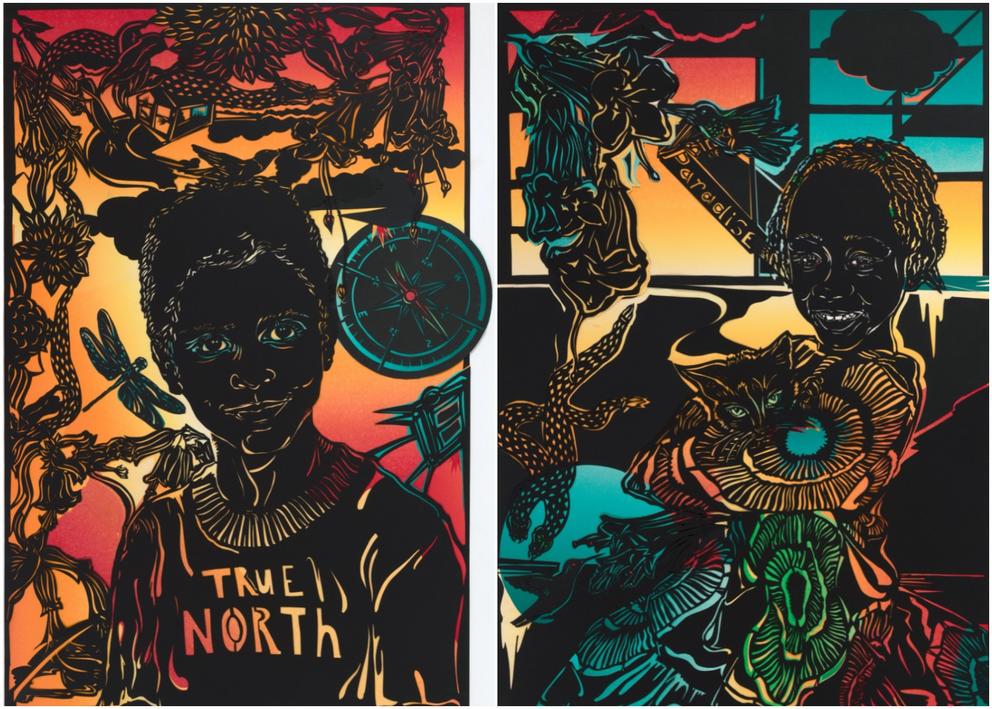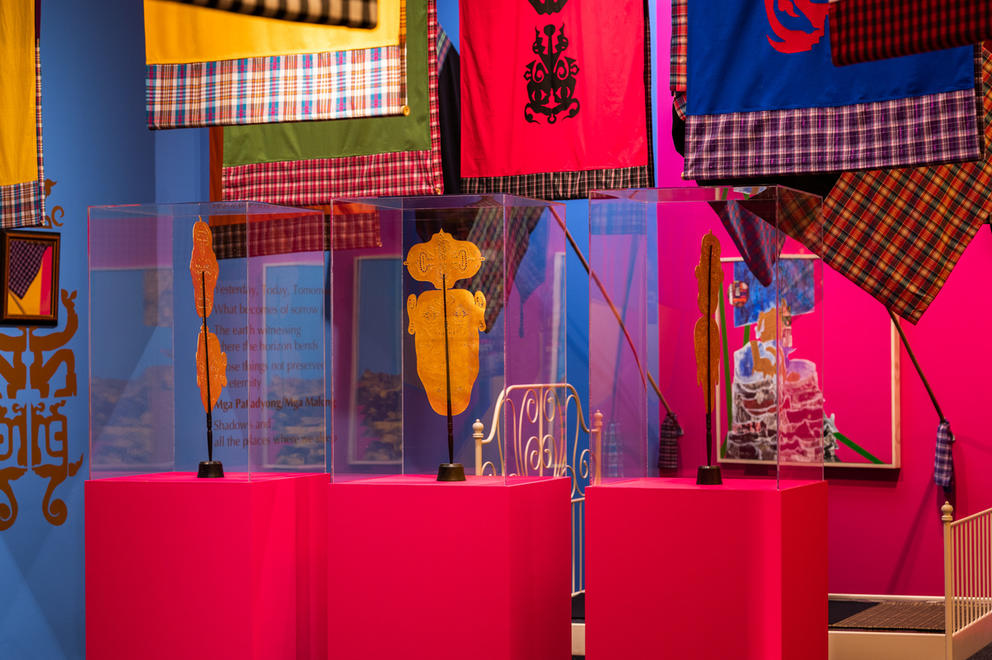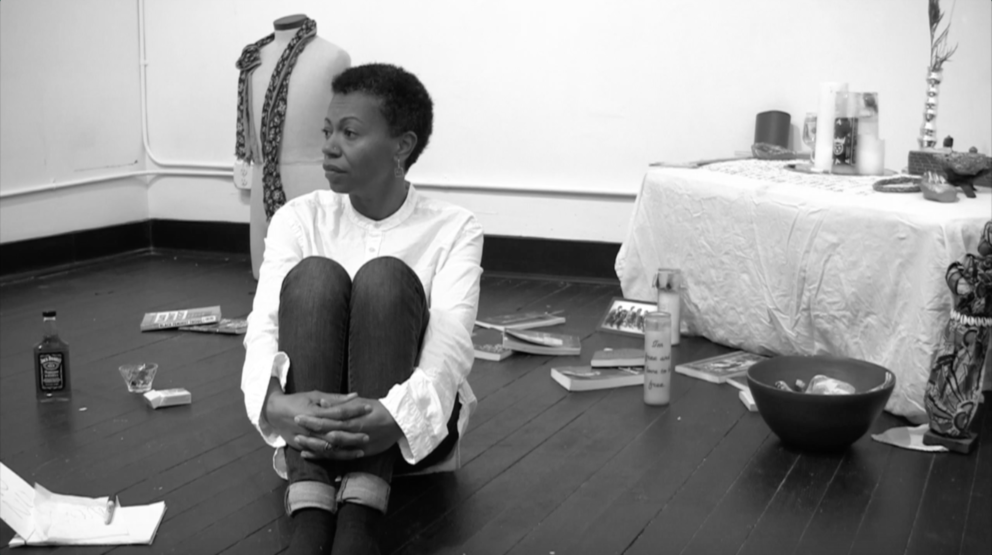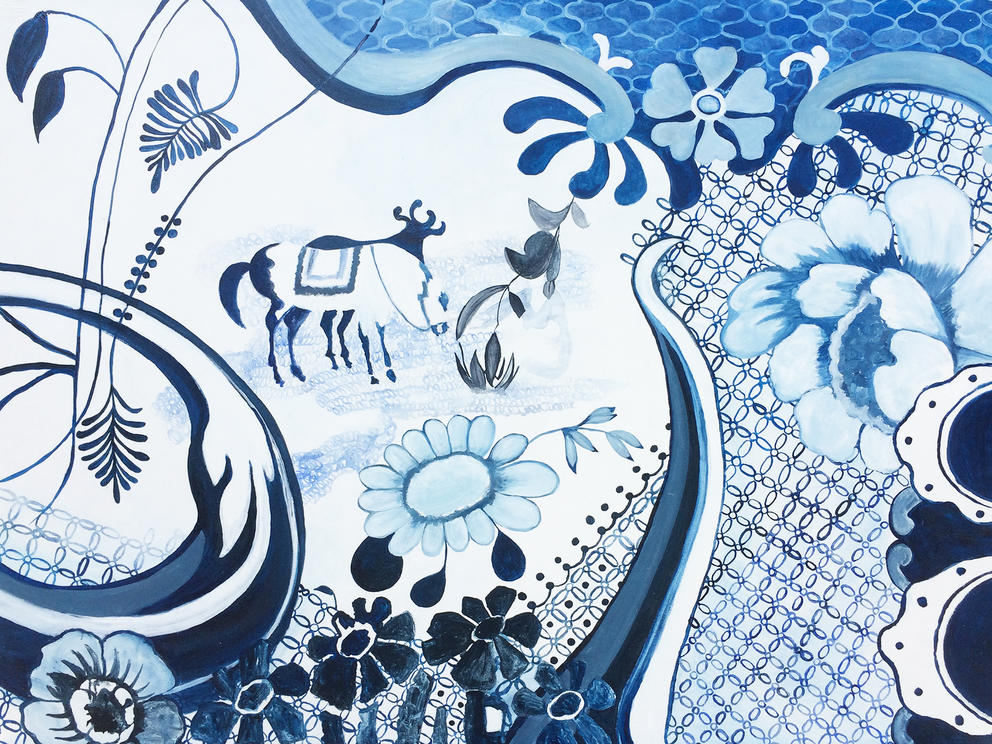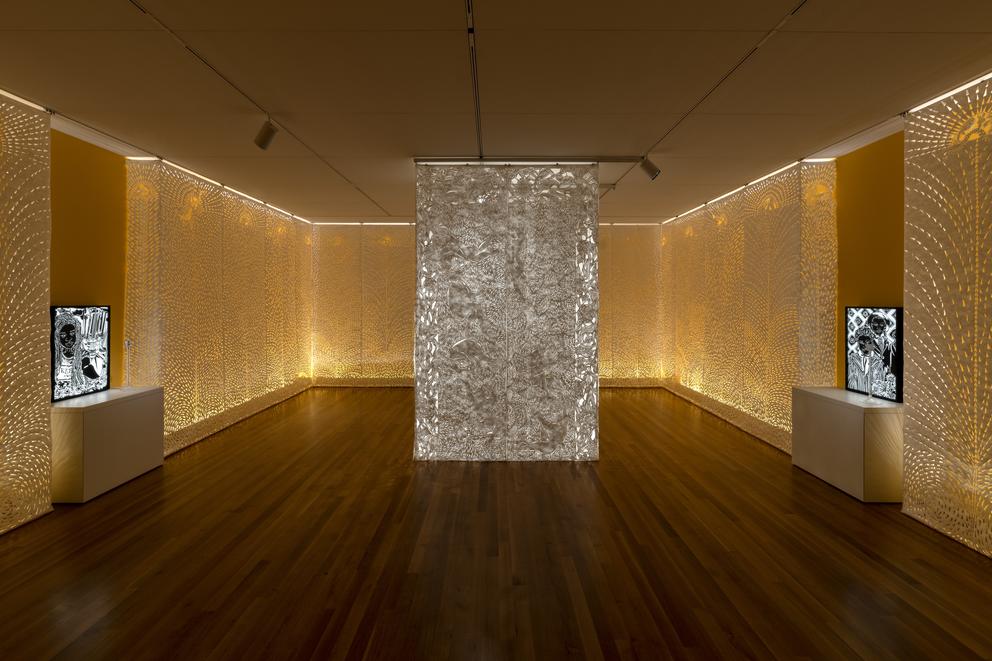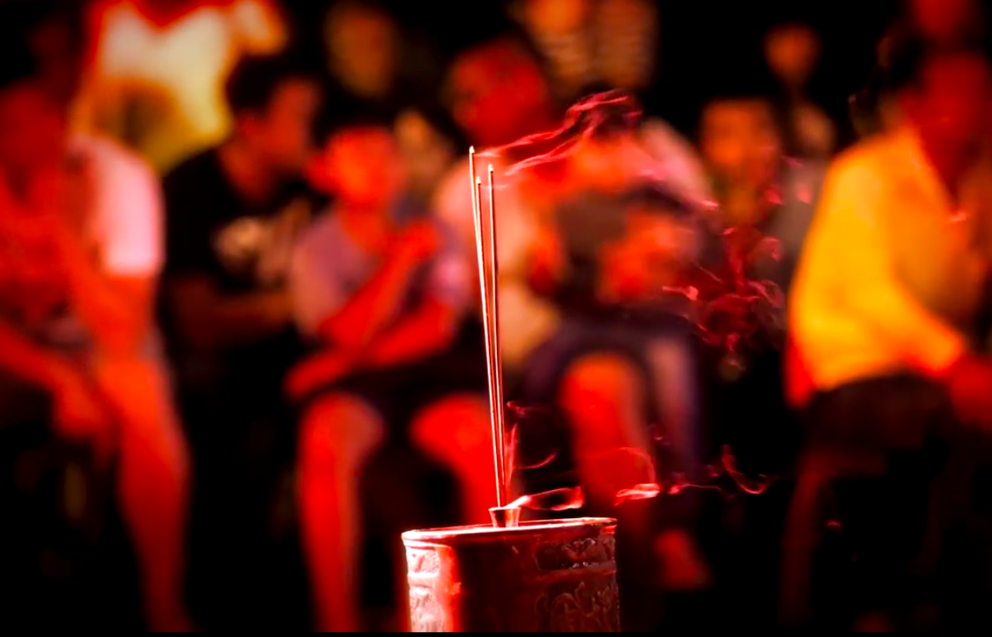Immersive color at Bellevue Arts Museum
On a recent visit to the group show Yellow No. 5 at Bellevue Arts Museum, I felt like my eyes were two balls bumping around in a pinball machine: Colorful walls and tantalizing objects (A giant log made from cardboard! A rotating megasized lunch box! Hennessy on a pedestal!) vied for my attention, tossing me from one polychromatic display to the next. One such gallery, by Seattle artist Romson Regarde Bustillo, exerted an irresistible pull, thanks to hot-pink and bright yellow walls hung with intricate, textured abstract collages. Checkered banners dangling from the ceiling gently waved me in. Though displayed as flags, these are patadyong, a tubelike wraparound skirt worn in the Philippines.
With this installation (called Gahapon, Karon, Ugma, or Yesterday, Today, Tomorrow), Bustillo honors the art and cultural traditions of his ancestors, which the artist melds into something recognizable but new. As for the rest of the show, there’s not enough space here to recognize the work of all the artists — Aramis O. Hamer, Christopher Paul Jordan, Monyee Chau, Clyde Petersen, SuttonBeresCuller, Ari Glass and Kenji Hamai Stoll, brought together by Seattle curator Tariqa Waters. Suffice to say: this show is best experienced in person. “I want the space to look like a children’s museum,” Waters told me last year. “I want it to be all immersive where it's a bit disorienting.”
If you go: The Bellevue Arts Museum is open. Yellow No. 5 runs through April 18.
While you’re there: It’s impossible to pick between two other gripping shows currently hanging, so we suggest you check out both. One is an overwhelming wall of hundreds of blue china plates all painted by Oregon artist Julie Green, with the final meals requested by inmates on death row: Kentucky Fried Chicken, a single, store-bought cinnamon roll, steak, and nothing at all. The other, a collection of (literally) graphic black-and-white wheat-paste posters by artist Piotr Szyhalski (popular on Instagram as @laborcamp), is equally political and disorienting, as it recounts the failures, uprisings and deaths of 2020 by way of monochrome gut punches. Julie Green: The Last Supper runs through Oct. 21. Piotr Szyhalski: COVID-19: Labor Camp Report runs through July 4.
The cancer of ‘keep going’ at the Frye Art Museum
“I do yoga. I read. I’m fine,” Alice Metropolis assures us from the black-and-white video screen, a bottle of liquor in hand. She goes to therapy. She’s working on being fine. She’s just gotta keep it going, keep it moving, stick to the plan. But the plan’s not working. Even in savasana, she doesn’t feel like she can rest.
Alice isn’t real: She’s a fictional character dreamed up by Seattle poet and artist Anastacia-Reneé. But Alice’s story, which Anastacia-Reneé tells through videos, wall poetry, installations of blood-spattered white laundry and piles of gifts inscribed with words like “home” and “sanctuary” rings true.
From Alice’s interior monologues emerges a portrait of her body as a house near-crumbling under the pressures of gentrification, redlining and white supremacy. But the rot, the cancer, is already in the walls. Wellness culture and kale and sleep and smoothies won’t patch this up, won’t stop the white liberals from invading her neighborhood, police from breaking down her door or cancer cells from taking over her body. In one video, Alice checks her breast for lumps, asking, “Cancer, are you still there?” She answers her own question: “Yep.”
If you go: Frye Art Museum is now open. Anastacia-Reneé: (Don’t Be Absurd) Alice in Parts runs through April 25.
While you’re there: You don’t even have to go inside the museum to see this art show, a billboard-sized banner by local artist Marilyn Montufar. Looking at the black-and-white photo of Montufar’s subjects and friends “Ronnie and Cleveland,” from the busy Boren Avenue arterial, it feels like the artist is letting us in on an intimate moment. Boren Banner Series: Marilyn Montufar runs through April 11.
Shades and shards of blue at the National Nordic Museum
Shards of antique ceramics regularly speckle the soil and sand of St. Croix, one of the U.S. Virgin Islands. These fragments emerge from the grounds of former plantations after vigorous rainfalls, or get washed ashore by ocean waves. Called Chaney, a portmanteau of “china” and “money,” these (often blue and white) fragments form visual reminders of Danish and European colonialism in the Virgin Islands, where St. Croix-based artist La Vaughn Belle grew up.
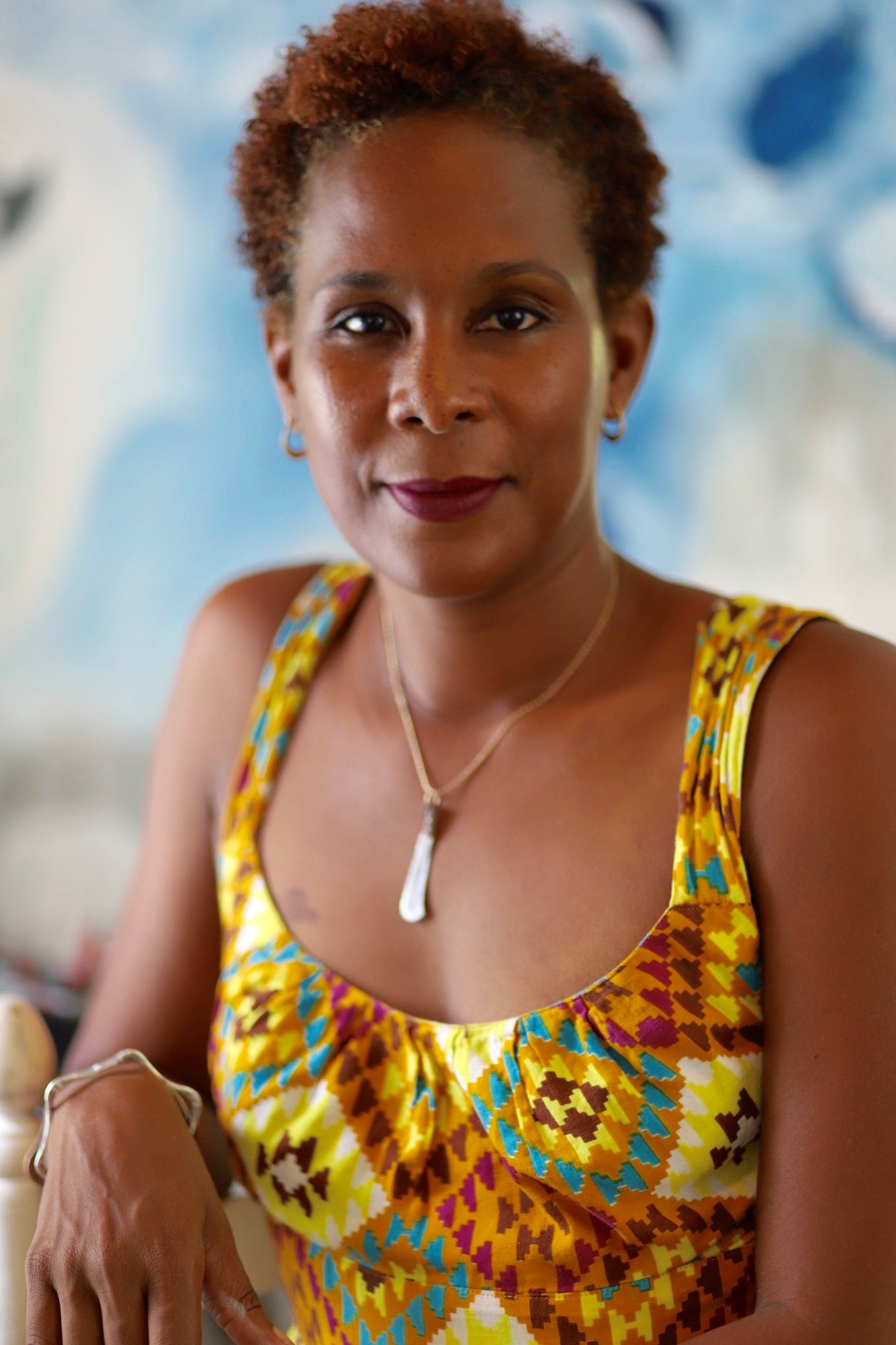
Once, admiring plates at the Royal Copenhagen ceramic store on a trip to Denmark, Belle realized she seen only shards her whole life — never a complete plate. Since 2014, she’s been piecing the fragments back together with paintings in a series called Chaney (We Live in the Fragments) as a way to defy the “cultural amnesia” of colonialism.
Belle collages and combines the designs featured in colonial plates — fish-scale patterns, chain links and slender vines abutting bucolic farm scenes, tiny dots and flourishes of oversized flowers — all in shades upon shades of blue: cobalt, navy, arctic, indigo, cerulean.
At the National Nordic Museum, the Chaney paintings hang at different heights and irregular intervals to re-create the feeling of finding disparate shards. Here, it’s neither the rain nor waves, but Belle who brings these fragments of history to the surface.
If you go: The National Nordic Museum reopens Feb. 18. La Vaughn Belle: A History of Unruly Returns runs through April 11.
While you’re there: Artists beware: If you end up as famous as Norwegian artist Edvard Munch (the progenitor of “The Scream”), your experimental selfies and aimless snapshots might just end up in a major museum. From Munch’s square, often ghostly black-and-white photos emerges an introspective portrait of an artist searching for himself. The Experimental Self: Edvard Munch’s Photography runs through April 18.
Cutting-edge paper at Seattle Art Museum
A beacon of light beckons visitors into a tucked-away gallery of the Seattle Art Museum, where a large paper pillar glows from lamps within. The room, wallpapered with large backlit Tyvek scrolls rising up like columns, is lit in a spectral golden glow. The light oozes through thin slits and incisions carefully made by Seattle artist Barbara Earl Thomas. In cutting away, she has conjured up near-biblical scenes of writhing snakes, buzzing bees, blooming flowers and human silhouettes falling, struggling and embracing.
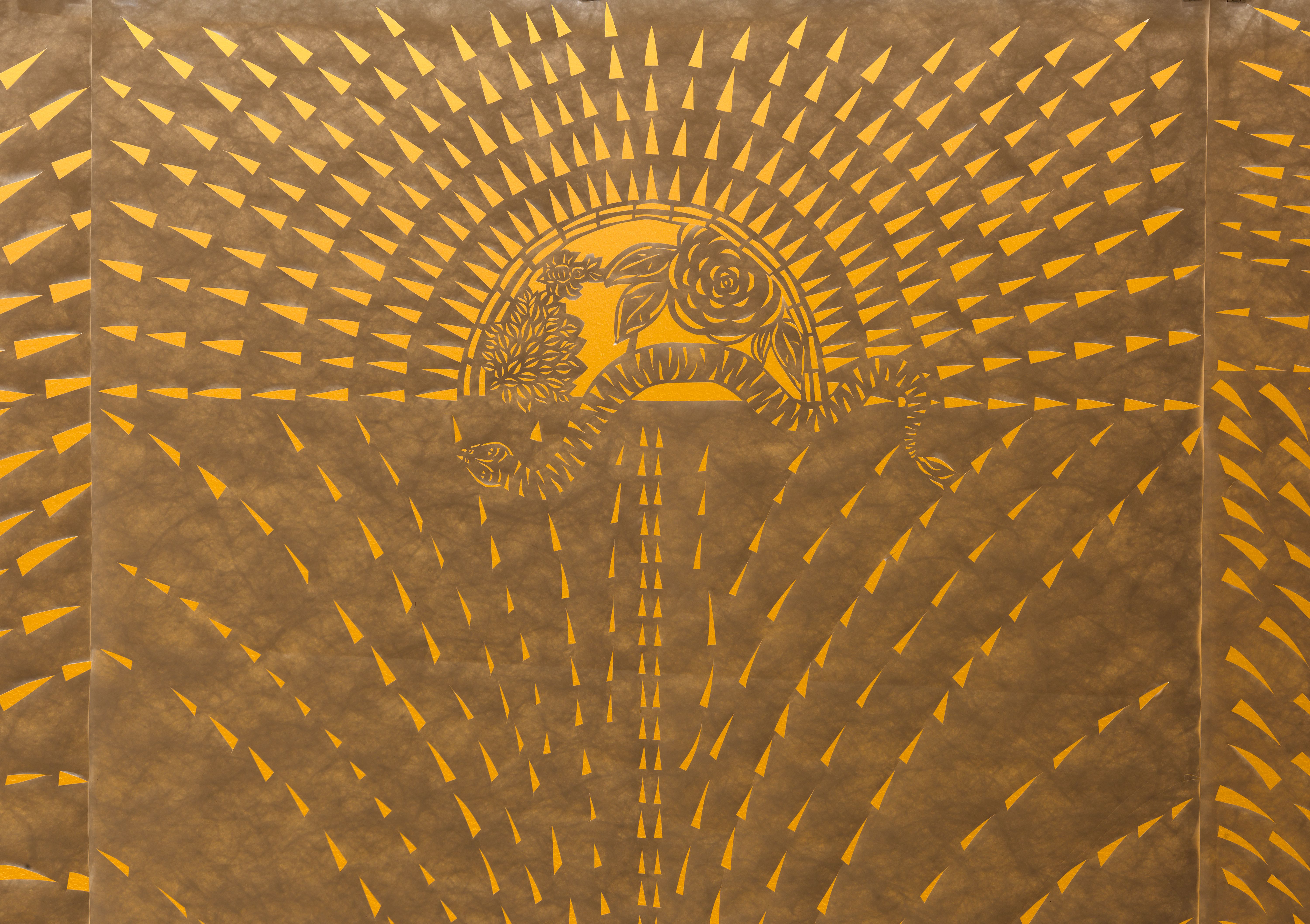
These paper scenes are interspersed with white altars topped with hand-blown glass candelabras, giving the gallery a churchlike feel. This spiritual sense is heightened by Thomas’ portraits of Black children, rendered in black paper cutouts placed on top of paper streaked with blue, yellow, orange and red — like stained glass windows into the soul. Thomas hopes these portraits will inspire visitors to consider the tender age and vulnerability of these kids. How do you “read” these faces? How do your internalized and projected values change their topography? “In this exhibition,” Thomas told SAM, “I ponder what comes with our preconceived notions of innocence and guilt, assigned in shades of light and dark, black and white.”
If you go: Seattle Art Museum reopens March 5. Barbara Earl Thomas: The Geography of Innocence runs through Nov. 14.
While you’re there: SAM reopens with a bang, thanks to the arrival of Jacob Lawrence’s 30-panel series Struggle ... From the History of the American People (1954-56), in which the acclaimed artist and longtime Seattle resident and teacher (of, among others, Barbara Earl Thomas) reimagined American history as a shared struggle. The panels are on view together for the first time in more than 60 years, and this show is the only West Coast stop on a national tour. Jacob Lawrence: The American Struggle series runs March 5-May 23.
Searching for home at the Wing Luke Museum
“In the palace of memory, children of the diaspora walk through empty rooms and turn the pages of unfixed photo albums, asking, ‘Where do I belong?’” Words by Seattle poet Shin Yu Pai grace the wall text for the new exhibit Paths Intertwined, featuring work by local artists of the Taiwanese and Chinese diaspora. Though it takes up only one room, it feels expansive, as a multitude of works by each artist transports visitors to Taiwan, Hong Kong and China. We follow Shin Yu Pai, for example, to the Wang Yeh Boat Burning Festival, a Taoist ritual in the southern port town of Donggang, Taiwan. The video screen lights up with flames as Pai’s verses smolder through the speakers.
In hazy, evocative Gerhard Richter-like paintings hanging nearby, Larine Chung reconstructs the Hong Kong of her youth — streets wet after the rain, busy eateries — memories blurred by time, as if Chung is looking in through foggy windows. Windows also make an appearance in a few small, punchy wall hangings by May Kytonen, who embroiders HGTV Dream Home floor plans onto cotton fabric with black yarn. Exhibited in clear boxes decorated with lattice designs from traditional Chinese window panes, they represent layers of identity.
If you go: The Wing Luke Museum reopens March 5. Paths Intertwined runs through Nov. 7.
While you’re there: Though Guilty Party doesn’t feature Seattle-area artists, these intriguing multimedia works by U.S.-based Asian Pacific American artists make the show well worth a visit. Highlights: Eyeballs with hair extensions dangling from the ceiling (courtesy of Chanel Matsunami Govreau) and the uncanny (and gory!) feminist photography by art collective Mail Order Brides. Guilty Party runs through Nov. 16.
Get the latest in local arts and culture
This weekly newsletter brings arts news and cultural events straight to your inbox.

